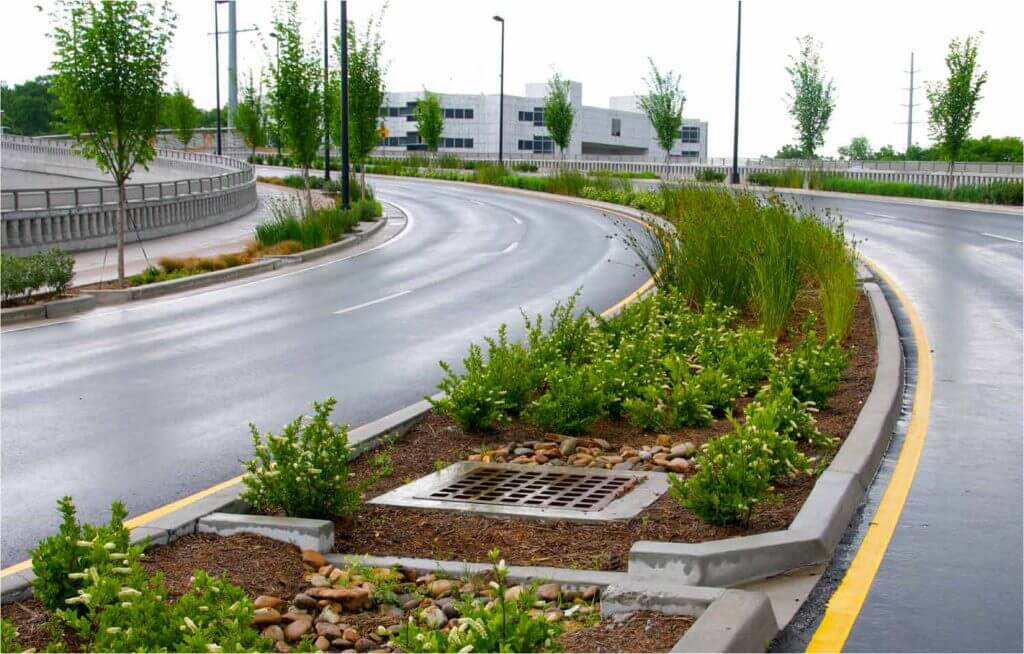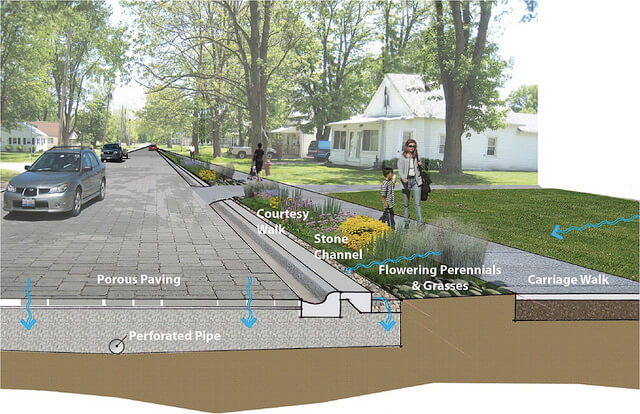Green Streets: Restoring Rivers, Revitalizing Neighborhoods, and Making Streets Safer
The stormwater that hits our streets, sidewalks and alleys carries pollutants, causes soil erosion and flooding, makes sewers overflow, and leads to unnatural highs and lows in stream flows. Green streets incorporate green infrastructure (like trees, rain gardens and permeable pavement) in order to manage and treat the stormwater that flows off of the street. The goal of green streets, and other types of green infrastructure, is to collect water close to where it falls, treat it with a combination of soils and plant material, and other practices that replicate natural hydrology, and let it sink back into the earth or evapotranspire, through plant uptake.
Many cities have led the way and focused significant attention and resources on retrofitting their streets and alleys with green infrastructure (see a list here), and for good reason. Streets represent a significant percentage, sometimes the greatest percentage, of the overall impervious cover in a city. For example, streets represent 38% of the impervious cover in Philadelphia.

Photo credit (c) Hawkins Partners, Inc.
Not only does green street infrastructure control and treat stormwater runoff, it can also help meet urban revitalization, beautification, “Complete Streets,” and “Safe Routes to School” goals. Complete Streets are designed and operated to enable safe access for all users, regardless of age, ability, or mode of transportation. Safe Routes to School are designed to improve the health and well-being of children by enabling and encouraging them to walk and bicycle to school. Green street infrastructure can provide multiple benefits including treatment of stormwater, beautification, calming traffic, providing buffers for cyclists and pedestrians, and reducing the distance pedestrians have to travel in order to cross a street.

Photo credit (c) American Rivers
To build understanding of the positive outcomes of green streets implementation, River Network, in collaboration with Hawkins Partners, Inc., Smart Growth America, and Cumberland River Compact developed a process to support city administrators, planners, designers, and environmental advocates in determining the potential – and developing strategies – for green streets.
The goal of this project is to encourage the practice of integrating stormwater and transportation infrastructure by developing a straightforward process for identifying the best locations for green street stormwater practices. Promoting Green Streets – A Recipe for Integrating Water and Transportation Infrastructure Investment guides users through the process of identifying the best locations for green streets in their communities.
Learn More
- Promoting Green Streets – A Recipe for Integrating Water and Transportation Infrastructure Investment by River Network
- Green Streets: Filtering and Slowing Stormwater, Revitalizing Neighborhoods and Making Streets Safer Webinar by River Network/Urban Waters Learning Network
- River Rally 2016 Session: Promoting Green Streets – A Recipe for Integrating Water and Transportation Infrastructure Investment by River Network
- July 2015 Issue of River Voices: Green Infrastructure and Urban Rivers, Turning Our Cities Blue by River Network
- Green Streets Resources Guide by River Network
- Municipal Green Streets Projects and Resources Guide by River Network




